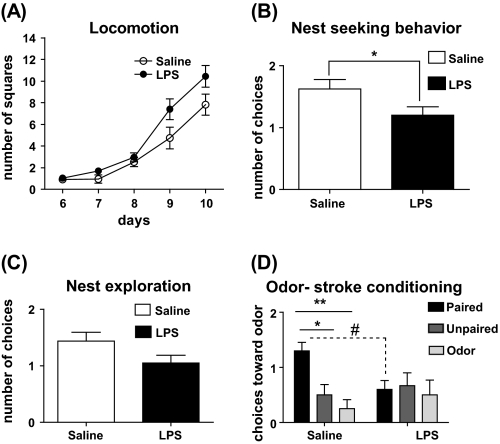Fig. 4.
(A) Locomotor activity (n = 24–27 per treatment): the scoring was done based on the number of line crossings by each pup during 3-minute observation period. The data were analyzed using 2-way ANOVA with time as repeated measurement. (B) Nest-seeking behavior (n = 16–20 per treatment): data presented as number of approaches toward maternal nest (observation time: 60 s). Each pup was assigned to 2 trials. The data were analyzed by 2-tailed Student t test (*P < .05). (C) Nest exploration: number of choices toward maternal nest plus exploration of the nest was considered a positive score and analyzed by 2-tailed Student t test (P = .0692). (D) Odor-stroke associative learning: number of choices toward the conditioned odor at day P9 in saline- and lipopolysaccharide (LPS)-treated offspring that received either paired odor-stroke (n = 10–11) or unpaired odor-stroke (n = 8–9) or odor-only (n = 8–10) presentation on the training day (P8). Two-way ANOVA of data showed that in saline group, odor-stroke paired pups made more entries toward the side of conditioned odor compared with unpaired or odor-only groups (*P < .05 and **P < .01, respectively). Furthermore, within paired group, the LPS-treated pups made significantly fewer choices toward conditioned odor comparing to saline (#P < .05).

